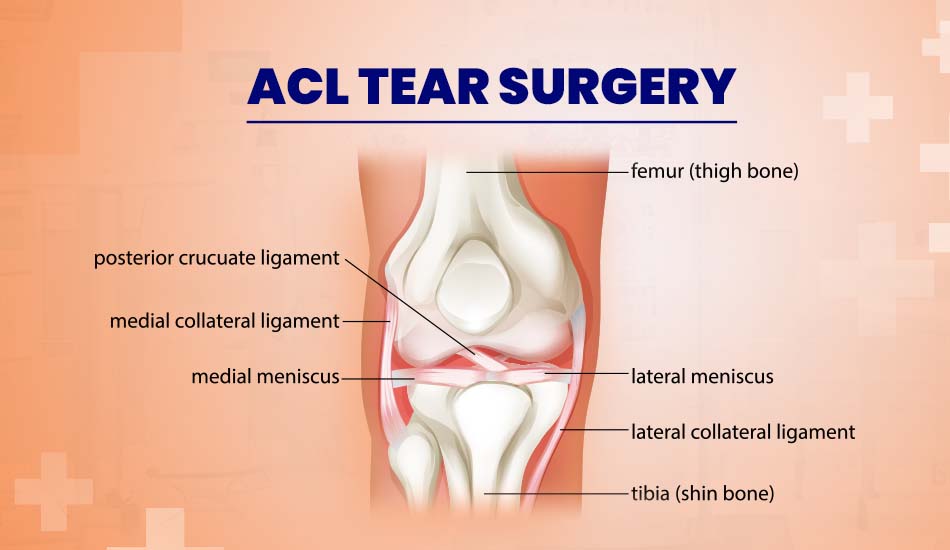
ACL Tear Surgery Explained: Steps, Recovery, and Success Stories
Wednesday, 22nd May 2024An ACL tear is a common injury, especially among athletes, and can significantly impact daily activities and physical performance. Understanding the surgery process, recovery journey, and hearing success stories can provide valuable insights and hope. This article offers a detailed explanation of ACL tear surgery, the steps involved, the recovery process, and inspiring success stories.
What is an ACL Tear?
The anterior cruciate ligament (ACL) is one of the major ligaments in the knee that helps stabilize the joint. An ACL tear often occurs due to sudden stops, changes in direction, or direct impact during sports activities. Symptoms include a popping sound at the time of injury, severe pain, swelling, and knee instability.
Steps Involved in ACL Tear Surgery
1. Initial Consultation and Diagnosis
Before surgery, a thorough evaluation is necessary:
- Physical Examination: The doctor assesses the knee for swelling, tenderness, and range of motion.
- Imaging Tests: An MRI is commonly used to confirm the ACL tear and check for other injuries.
2. Pre-Surgery Preparations
Preparing for ACL surgery involves several steps:
- Physical Therapy: Pre-surgery therapy may be recommended to strengthen the muscles around the knee and improve range of motion.
- Medical Clearance: A general health check ensures the patient is fit for surgery.
- Pre-Surgery Instructions: Patients receive guidelines, including fasting before the procedure and arranging post-surgery transportation.
3. The Surgical Procedure
ACL reconstruction surgery typically involves the following steps:
- Anesthesia: General or regional anesthesia is administered to ensure the patient is comfortable.
- Graft Harvesting: A tendon graft (either autograft from the patient or allograft from a donor) is prepared.
- Arthroscopy: Small incisions are made, and an arthroscope (camera) is inserted to visualize the knee.
- Tendon Graft Placement: The surgeon drills tunnels in the femur and tibia to place the graft, replicating the function of the torn ACL.
- Securing the Graft: The graft is secured with screws or other fixation devices.
- Closing the Incisions: The incisions are closed with sutures or staples, and a bandage is applied.
Recovery Process After ACL Tear Surgery
Immediate Post-Surgery Care
- Pain Management: Pain medications and anti-inflammatory drugs help manage post-surgery pain.
- Rest and Ice: Resting the knee and applying ice helps reduce swelling.
- Use of Crutches: Crutches are used to keep weight off the knee during the initial healing phase.
Rehabilitation and Physical Therapy
Rehabilitation is crucial for a successful recovery:
- Phase 1 (Weeks 1-4): Focus on reducing swelling, regaining range of motion, and beginning light strengthening exercises.
- Phase 2 (Months 1-3): Gradual increase in strength training, balance exercises, and more intense physical therapy.
- Phase 3 (Months 4-6): Advanced strengthening, agility drills, and preparing for a return to sports or high-impact activities.
Long-Term Recovery
- Monitoring Progress: Regular follow-up visits with the surgeon to monitor healing and progress.
- Continued Strengthening: Ongoing exercises to maintain strength and flexibility.
- Safe Return to Activities: Gradual return to sports and physical activities, following the doctor’s guidelines.
Success Stories: Real Patient Experiences
Emily’s Comeback to Soccer
Emily, a college soccer player, tore her ACL during a game. Post-surgery, she dedicated herself to a rigorous rehabilitation program: "The surgery was just the beginning. The real challenge was sticking to the rehab plan. My physical therapist pushed me, and slowly, I regained my strength and confidence. A year later, I was back on the field, stronger and more determined than ever."
John’s Return to Hiking
John, an avid hiker in his 50s, feared he might never hike again after his ACL tear: "I love hiking, and the thought of giving it up was devastating. The surgery and recovery were tough, but my goal kept me motivated. Six months post-surgery, I was back on the trails, and I’ve been hiking regularly since."
Sarah’s Journey Back to Fitness
Sarah, a fitness enthusiast, shares her experience: "The first few weeks were the hardest. But with a great support system and a determined mindset, I followed my rehab plan diligently. Today, I’m back to my fitness routine and even participated in a local marathon."
Conclusion
ACL tear surgery, while challenging, can lead to a successful recovery and return to an active lifestyle. Understanding the surgery steps, committing to the rehabilitation process, and drawing inspiration from real patient stories can help individuals navigate their journey from injury to recovery. If you’re facing an ACL tear, consult with a qualified orthopedic surgeon, stay committed to your recovery plan, and look forward to regaining your active life.


